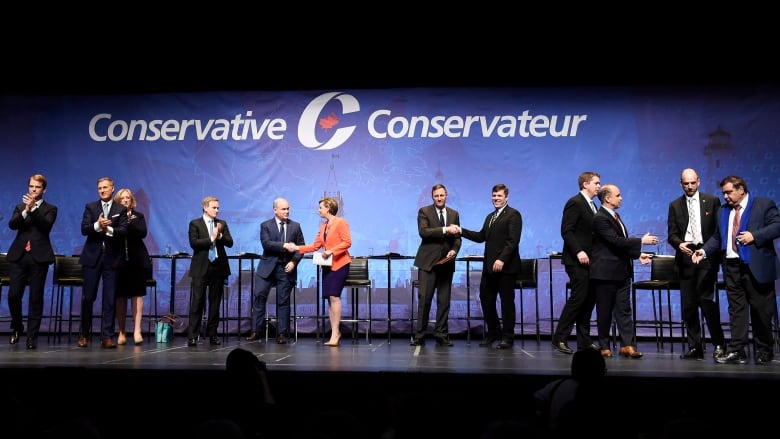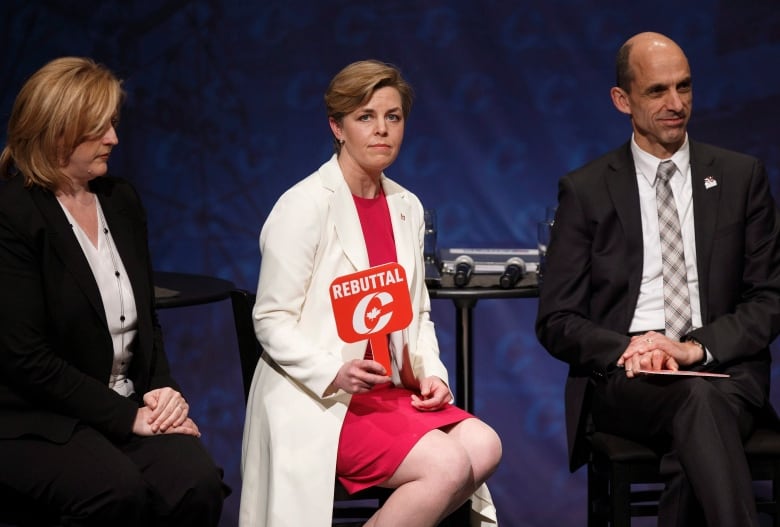How the Conservatives' leadership rules could limit the field this time
Raising $300,000 in 10 weeks is no small feat few candidates managed it in 2017

After listing 14 names on the ballot duringits last leadership race, the Conservative Party seems to be on track fora more intimate affair this time around.
The party has set the bar quite high for prospective candidates so highthatnearly all of 2017's contestants would have failed to qualify for the current race.
The leadership contest that chose Andrew Scheer in May 2017 was an unwieldy beast. Seventeen candidates put their names forward and 15 made it far enough to participate in at least one debate.
But that long list of contenders didn't mean members had awealth of popular choices. Half of the 14 people on the ballot failedto secure even four per cent of the vote before they were eliminated. Three of them finished with less than one per cent.

The rules for entry in 2017 weren't particularly demanding. Theyrequired candidates to drum up $100,000 and 300 signatures from members in good standing and gave them nearly a year to do it.
Not this time.
To be considered "verified candidates" in 2020, contestants will need to submit $300,000 to the party, including a $100,000 refundable compliance deposit. Candidates also will need to find 3,000 signatures from members living across the country. And they need to do it all by March25 in order to get on the ballot for the June27 vote.
That's a tight deadline so tight that most of 2017's candidates wouldn't have made the cut.
The $300,000 question
Lots of money was raised during the last leadership race. Together, the contestants brought in over $10 million, with the Conservative Party's owncoffers receiving 10 per cent of that total.
Nine contestants raised at least $300,000 each: Scheer, Maxime Bernier, Michael Chong, Kellie Leitch, Pierre Lemieux, Kevin O'Leary, Erin O'Toole, Lisa Raitt andBrad Trost.
But it took them a long time to do it. This year'sConservative race officially started on Monday, giving prospective candidates just 72 days to raise enough money and find enough signatures to meet the party's qualifications.
That's not a lot of time. Startingfrom the date he accepted his first donation, O'Leary managed to raise $300,000 within 12 days. No other candidate raised that much money in their first 72 days.
The initial $25,000 is relatively easy Elections Canada allows candidatesto donate that much of their own money to their leadership campaign. But the rest has to be raised fromindividual donors giving no more than $1,625apiece.
Putting the money together that way can take some time. Based on his performance in 2017, and taking into account the Conservative Party's tithe, it would have taken Scheer 120 days to hit the $300,000threshold.
On average, it took contestants 143 days to raise their first $300,000 in the 2017 race nearly twice as long as candidates will have in 2020.
There might have been less urgency in 2017 due to the length of the race but even accounting for that, few candidates were able to raise so much money in so short aperiod of time. Only the top-three finishers Scheer, Bernier and O'Toole raised at least $300,000 in thelast 72 days of the 2017 contest.
Members, members everywhere
All of this suggests that the new rules will limit the race to those candidates who have a profile high enough to raise a lot of money, and an organization strong enough to gather the needed signatures, in such a short amount of time.
Not only do candidates need to find 3,000 signatures, those names need to come from at least 30 different ridings across at least seven different provinces or territories.
That requires a national organization, but it also gives an advantage to candidates whose base is where a lot of party members live. Technically, a qualifying candidate could gather 2,971 signatures from a single riding as long as the other 29 come from 29 different ridings spread across the country.
Some 65,000 Conservative Party members living in Ontario voted in the 2017 leadership race, along with about 29,000 in Alberta and 19,000 in British Columbia.
But there were fewer than 10,000 voting members in Quebec at the time, and a little more than 6,000 in all of Atlantic Canada. While it's unlikely to be a major obstacle for the top tier of potential candidates, those withonlylimited local profiles may struggle to collect the signatures they need to get into the race.

None of this is likely to prove an insurmountable challenge to high-profile people like Jean Charest, Peter MacKayor Rona Ambrose if they decide to run. Nor is it likely to be much of a hurdle for potential candidates like O'Toole or Pierre Poilievre, who are well-known within the Conservative Party even if they aren't household names.
But the lower-profile candidates the obscure businesspeople, the unknown backbenchers, the former MPs desperate to make a comeback might be scarcethis time around.
The rules already may be having an effect.
CBC News has learned Bryan Brulotte, a veteran political organizer and businessman who was the first to publicly declare his intention to seek the leadership in December, has decided to drop out and is advocating for former Conservative cabinet minister Peter MacKay to run instead.
"Although my desire was to serve and continues to be a motivating factor, after careful consideration and review of the recently published regulations, I have decided to withdraw from the leadership race for the Conservative Party," Brulotte said in a press release shared withCBC News.

with files from Hannah Thibedeau













_(720p).jpg)


 OFFICIAL HD MUSIC VIDEO.jpg)
.jpg)



























































































